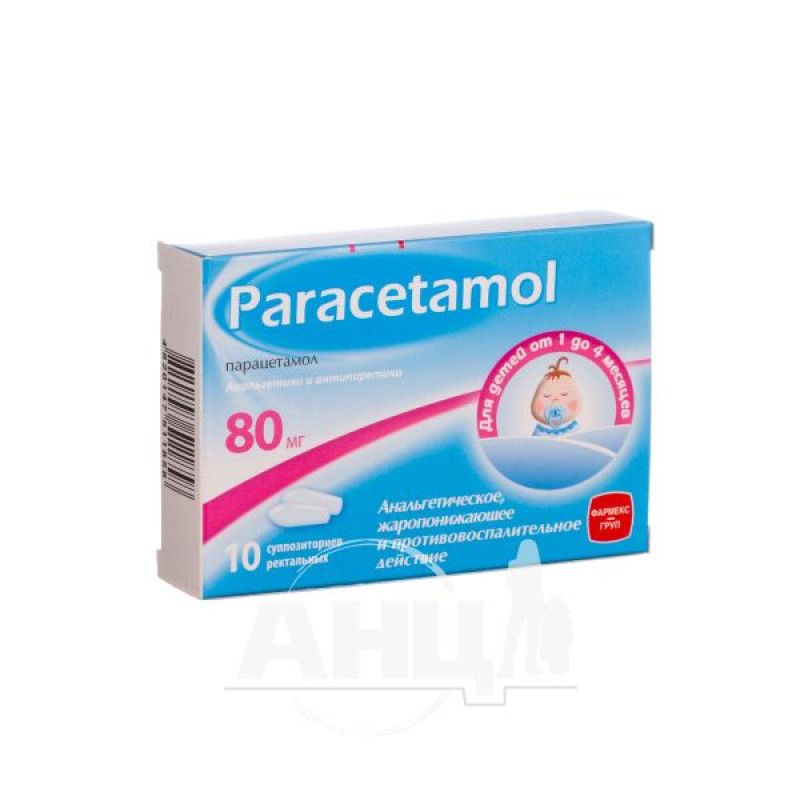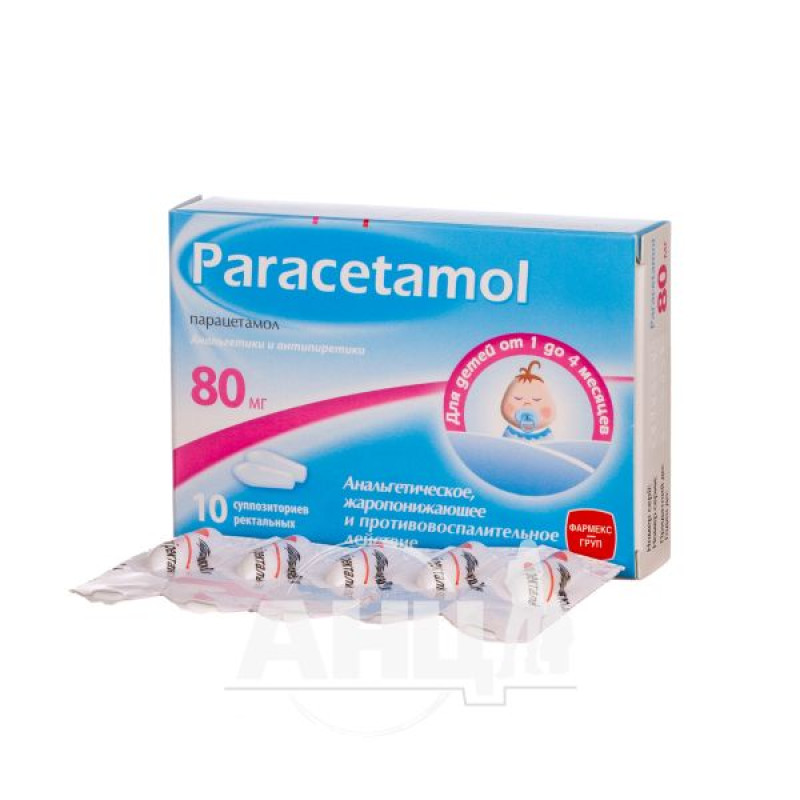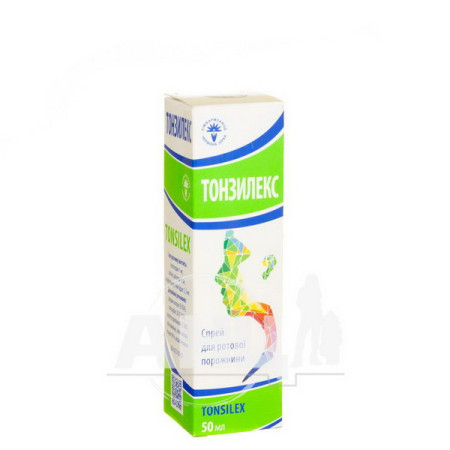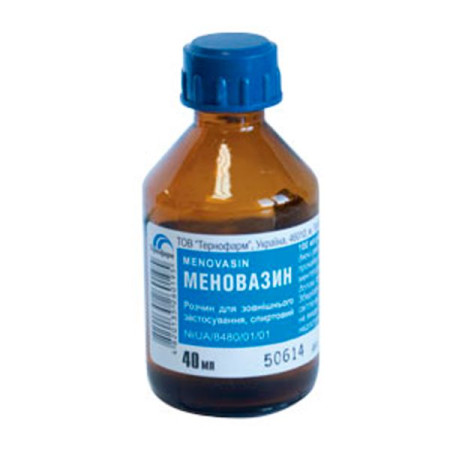Paracetamol rectal suppositories 80 mg strip No. 10

Translation of the instructions can be
PARACETAMOL rectal suppositories 80 mg, rectal suppositories 150 mg
Instruction
For medical use of the medicinal product
Paracetamol
(Paracetamol)
Composition:
Active ingredient: paracetamol;
1 rectal suppository contains 80 mg or 150 mg of paracetamol;
excipient: solid fat.
Dosage form.
Rectal suppositories.
Main physicochemical properties: smooth suppositories of white or almost white color. There are no inclusions on the longitudinal section, the presence of a funnel-shaped depression and an air core is allowed.
Pharmacotherapeutic group.
Analgesics and antipyretics. ATC code n02b e01.
Pharmacological properties.
Pharmacodynamics.
It has analgesic, antipyretic and weak anti-inflammatory effects. The mechanism of action is due to inhibition of prostaglandin synthesis and a predominant effect on the thermoregulation center in the hypothalamus.
Pharmacokinetics.
Absorption of paracetamol by rectal administration is slower than by oral administration, but it is more complete. Peak plasma concentrations are reached within 2-3 hours after administration.
Paracetamol is rapidly distributed in all tissues. Concentrations in blood, saliva and plasma are comparable. Binding to plasma proteins is weak.
Paracetamol is metabolized mainly in the liver with the formation of inactive compounds with glucuronic acid and sulfates.
A minimal metabolic pathway catalyzed by cytochrome P450 leads to the formation of an intermediate (N-acetylbenzoquinoneimine), which under normal conditions is rapidly detoxified by reduced glutathione and excreted in the urine after conjugation with cysteine and mercaptopurine acid. However, in cases of massive poisoning, the amount of this toxic metabolite increases.
Excreted mainly in the urine. 90% of the administered dose of paracetamol is excreted by the kidneys within 24 hours, mainly in the form of glucuronide conjugates (60 to 80%) and sulfate conjugates (20% to 30%).
Less than 5% of the substance is excreted unchanged.
The half-life is 4 to 5 hours.
In severe renal failure (creatinine clearance below 10 ml/min), the elimination of paracetamol and its metabolites is slower.
Clinical characteristics.
Indication.
Symptomatic treatment of diseases accompanied by pain of mild to moderate intensity and/or fever.
Contraindication.
Hypersensitivity to paracetamol or to other components of the drug.
Children's age up to 1 month (child's body weight up to 4 kg).
Severe renal and/or hepatic dysfunction, congenital hyperbilirubinemia, glucose-6-phosphate dehydrogenase deficiency, alcoholism, blood diseases, severe anemia, leukopenia.
Inflammation of the rectal mucosa and dysfunction of the anus.
Do not use the drug for diarrhea.
Interaction with other drugs and other types of interactions.
When taking maximum doses of paracetamol (4 g/day) for at least 4 days, there is a risk of increased effect of oral anticoagulant and increased risk of bleeding. The INR (International Normalized Ratio) should be monitored at regular intervals. If necessary, the dose of oral anticoagulant should be adjusted during treatment with paracetamol.
The rate of absorption of paracetamol may be increased by metoclopramide and domperidone and decreased by cholestyramine. Barbiturates reduce the antipyretic effect of paracetamol. Anticonvulsants (including phenytoin, barbiturates, carbamazepine), which stimulate the activity of liver microsomal enzymes, may enhance the toxic effect of paracetamol on the liver due to an increase in the degree of conversion of the drug into hepatotoxic metabolites. With the simultaneous use of paracetamol with hepatotoxic agents, the hepatotoxic effect of the drug on the liver increases. Simultaneous use of high doses of paracetamol with isoniazid, rifampicin increases the risk of developing hepatotoxic syndrome. Paracetamol reduces the effectiveness of diuretics. Do not use simultaneously with alcohol.
High concentrations of paracetamol may affect laboratory results of blood glucose determination using the oxidase-peroxidase method and uric acid determination using the phosphotungstic acid method.
Application features.
Do not use the drug in children together with other products containing paracetamol.
When treating with paracetamol at a dose of 60 mg/kg/day, concomitant use of another antipyretic is justified only in case of ineffectiveness of paracetamol. The recommended doses should not be exceeded.
Do not use the drug for diarrhea.
If hyperthermia lasts more than 3 days from the start of treatment with the drug or your health condition worsens, you should consult a doctor.
Use during pregnancy or breastfeeding.
The drug in this dosage form should only be used in children.
The ability to influence the reaction speed when driving vehicles or other mechanisms.
The drug in this dosage form is used only in children.
Method of administration and doses.
Use rectally. Suppositories should not be divided to obtain the required dosage. If the required single dose is less than the content of one suppository, then after consulting a doctor, it is recommended to use other dosage forms of paracetamol (for example, oral solution).
When treating children, the dose should be calculated according to the child's body weight, and the appropriate dosage form should be selected accordingly. The approximate age of children based on body weight is given as a recommendation only.
Paracetamol, rectal suppositories, 80 mg is intended for children weighing 4 to 6 kg (approximately 1 to 4 months). Use 3 to 4 suppositories per day with an interval of 6 hours between administrations, depending on the child's body weight at the rate of 60 mg/kg/day.
Sample calculation when the child's body weight is 4 kg:
4 kg x 60 mg / 80 mg = 3 (up to three suppositories per day),
where:
60 mg - daily dose of paracetamol per 1 kg of body weight per day,
80 mg - the amount of paracetamol in one suppository.
Paracetamol, rectal suppositories, 150 mg is intended for children weighing 8 to 12 kg (approximately 6 months to 2 years). Use 3 to 4 suppositories per day at 6-hour intervals, depending on the child's body weight, at the rate of 60 mg/kg/day.
Sample calculation when the child's body weight is 10 kg:
10 kg x 60 mg / 150 mg = 4 (up to four suppositories per day),
where:
60 mg - daily dose of paracetamol per 1 kg of body weight per day,
150 mg - the amount of paracetamol in one suppository.
The recommended daily dose of paracetamol is about 60 mg/kg/body weight/day, which should be divided into 4 doses, i.e. 15 mg/kg body weight every 6 hours. In severe renal failure (creatinine clearance less than 10 ml/min), the interval between doses should be at least 8 hours.
The use involves the rectal administration of one 80 mg or 150 mg suppository, which can be repeated if necessary with an interval of at least 6 hours, but not exceeding the daily dose and the number of 4 suppositories per day.
Due to the risk of local toxicity, it is not recommended to use suppositories more than 4 times a day, and the duration of use with rectal administration should be minimal.
Children.
When treating children, the dosage regimen should be followed according to the child's body weight, and depending on this, the appropriate dosage form should be selected.
Paracetamol, rectal suppositories, 80 mg, is intended for children weighing 4 to 6 kg (approximately 1 month to 4 months).
Paracetamol, rectal suppositories, 150 mg, is intended for children weighing 8 to 12 kg (approximately 6 months to 2 years).
Overdose.
To avoid overdose, do not use other medicines containing paracetamol.
There is a risk of overdose in young children (drug overdose and accidental poisoning are common). This can be fatal.
For children weighing less than 37 kg, the maximum daily dose of paracetamol should not exceed 80 mg/kg body weight/day.
For children weighing 38 kg to 50 kg, the maximum daily dose of paracetamol should not exceed 3 g/day.
For children weighing more than 50 kg, the maximum daily dose of paracetamol should not exceed 4 g/day.
With a single dose of 150 mg/kg of body weight of a child, the drug can cause hepatocellular insufficiency, impaired glucose metabolism, metabolic acidosis, hemorrhages, hypoglycemia, encephalopathy, coma and lead to death. At the same time, the level of hepatic transaminase, lactate dehydrogenase and bilirubin increases, and within 12-48 hours the level of prothrombin decreases. Acute renal failure with acute tubular necrosis can manifest as severe pain in the lumbar region, hematuria, proteinuria and develop even in the absence of severe liver damage. Arrhythmia and pancreatitis have also been noted. With prolonged use of the drug in large doses, aplastic anemia, pancytopenia, agranulocytosis, neutropenia, leukopenia, thrombocytopenia may develop from the blood-forming organs. When taking large doses from the CNS (central nervous system) - dizziness, psychomotor agitation and disorientation; from the urinary system - nephrotoxicity (renal colic, interstitial nephritis, papillary necrosis); from the digestive system - hepatonecrosis. In patients with risk factors (long-term use of carbamazepine, phenobarbital, phenytoin, primidone, rifampicin, St. John's wort or other drugs that induce liver enzymes; alcohol abuse; insufficiency of the glutathione system, for example, malnutrition, AIDS, starvation, cystic fibrosis, cachexia), the use of 5 g or more of paracetamol can lead to liver damage. Liver damage may become apparent 12-48 hours after an overdose. In case of overdose, the patient should be taken to the hospital immediately, even if there are no early symptoms of overdose. Symptoms of overdose appear within the first 24 hours: nausea, vomiting, decreased appetite, pallor, abdominal pain. Symptoms may not reflect the severity of the overdose or the risk of damage.
Urgent measures:
immediate hospitalization; determination of paracetamol levels in blood plasma; gastric lavage; administration of the antidote N-acetylcysteine intravenously or methionine orally within the first 10 hours; symptomatic therapy.Allergic reactions: anaphylaxis, anaphylactic shock, angioedema, erythema, urticaria, skin itching, rash on the skin and mucous membranes, erythema multiforme, toxic epidermal necrolysis.
On the part of the hematopoietic system: anemia, sulfhemoglobinemia and methemoglobinemia (cyanosis, shortness of breath, heart pain), hemolytic anemia, thrombocytopenia, leukopenia and neutropenia.
Respiratory system: bronchospasm in patients sensitive to aspirin and other NSAIDs (nonsteroidal anti-inflammatory drugs).
On the part of the digestive system: nausea, epigastric pain, impaired liver function, increased activity of liver enzymes, usually without the development of jaundice, hepatonecrosis (dose-dependent effect).
On the part of the endocrine system: hypoglycemia, up to hypoglycemic coma.
Dosage form related: irritation of the rectum and anus.
If any adverse reactions occur, you should stop using the drug and be sure to consult a doctor.
Expiration date.
3 years.
Storage conditions.
Store in the original packaging at a temperature not exceeding 25 ° C. Keep out of the reach of children.
Packaging.
5 suppositories in a strip, 2 strips in a cardboard pack.
Vacation category.
Without a prescription.
Producer.
"Pharmex Group" LLC.
Location of production and its address of place of business.
Ukraine, 08301, Kyiv region, Boryspil city, Shevchenko st., building 100.
There are no reviews for this product.
There are no reviews for this product, be the first to leave your review.
No questions about this product, be the first and ask your question.





